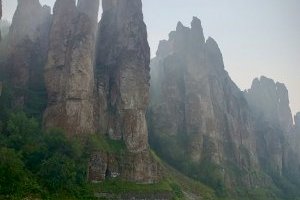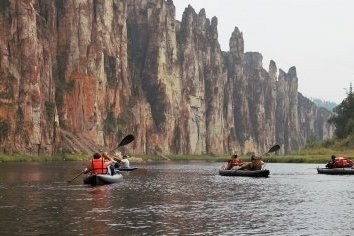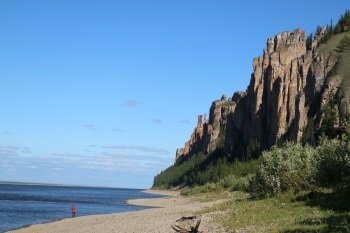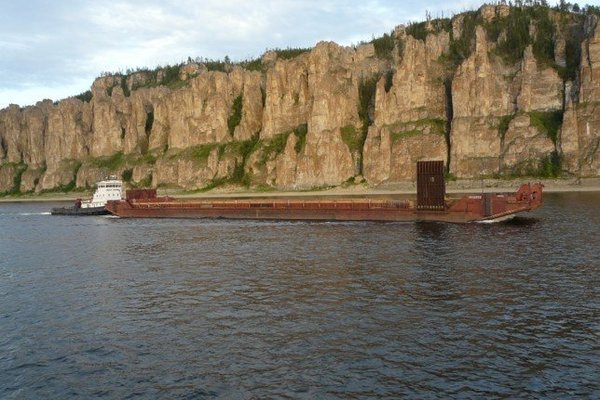Russia
Lena Pillars
Lena Pillars Nature Park is renowned for its rock pillar landscape and exposure of Cambrian rocks.
The park occupies the right bank of the middle part of the Lena River, which is lined by rock pillars up to 100m in height. They include fossilized reefs that carry among the most significant records of events related to the 'Cambrian explosion'.
Community Perspective: The site can be accessed from the Siberian town of Yakutsk, where tours are available for a combined jeep-boat visit. Martina and Alexander did it as a long day tour, while Lena kayaked the river for 10 days.
Site Info
Official Information
- Full Name
- Lena Pillars Nature Park (ID: 1299)
- Country
- Russia
- Status
-
Inscribed 2012
Site history
History of Lena Pillars
- 2012: Advisory Body overruled
- IUCN had asked for deferral. Also 1 criterium less was inscribed (vii)
- 2012: Inscribed
- Inscribed
- 2009: Requested by State Party to not be examined
- Type
- Natural
- Criteria
- viii
Links
- UNESCO
- whc.unesco.org
- Official
-
- lenskiestolby.ru — Lena Pillars Nature Park (in Russian)
- Related
-
- nhpfund.org — Nomination file
All Links
UNESCO.org
- whc.unesco.org — whc.unesco.org/
Official Website
- lenskiestolby.ru — Lena Pillars Nature Park (in Russian)
Related Resources
- nhpfund.org — Nomination file
News Article
- July 21, 2015 rt.com — Siberia's amazing Sinsky Pillars as seen from drone
Community Information
- Community Category
- Paleontology: Non-hominid fossils
- Natural landscape: Karst landscapes and caves
Travel Information
Recent Connections
-
Named after a River
The Lena river, the 11th longest river … -
No road access
Only by boat -
Paleozoic
The pillars are 150-300m (490-985ft) hi…
Connections of Lena Pillars
- Geography
-
-
Siberia
It lies in Yakutia -
Full White Nights
-
Isolated WHS
Roughly 1,500 KM from Lake Baikal
-
- Ecology
-
-
Hoodoo
-
Lagerstätten
Cambrian, Sinsk Algal Lens (wiki) - “The Sinsk Biota is the only Cambrian Lagerstatte occurring in carbonates" (nom file) -
Tundra
-
Fossils
the property preserves an exceptionally continuous, fully documented, and rich record of the diversification of skeletal animals and other biomineralised organisms from their first appearance until the first mass extinction event they suffered. The Lena Pillars include among the earliest and the largest, in both temporal and spatial senses, fossil metazoan reef of the Cambrian world. (crit viii) -
Bovines
Wood Bison (introduced) -
Dunes
Tukulans -
Significant Karst Features
Frozen karst and thermokarst in permafrost 100 - 500 m thick (AB ev) -
Permafrost Mounds
"At Lena Pillars Park, there are ......... bulgunnyakhs (also called pingo, an ice formation)" - Pravda -
Natural Arches and Bridges
See whc.unesco.org
-
Cambrian Explosion
The site also contains a wealth of Cambrian fossil remains of numerous species, some of them unique (Brief Description) -
Extreme temperatures
They were produced by the region’s extreme continental climate with an annual temperature range of almost 100 degrees Celsius (from –60 °C in winter to +40 °C in summer). (source: short description UNESCO website)
-
- World Heritage Process
-
-
Inscribed on a single criterion only
viii. to be outstanding examples representing major stages of earth's history, including the record of life, significant on-going geological processes in the development of landforms, or significant geomorphic or physiographic features -
WHC locations
St. Petersburg (2012) -
Minor modifications after inscription
2015: including the Sinyaya component, to be added as the Sinsky Plot (becomes a serial site) -
Natural sites filling gaps cited by IUCN
tundra
-
- Human Activity
-
-
Natural sites with indigenous human population
Evenk People "Traditional economic activity is led within the Park's area: licensed sable hunting, horse breeding in the Boutama River mouth, deer farming and haymaking. 884 thousand ha of land or about 60% of area of the Park are assigned to 6 Evenk ancestral farms." (nom file) -
Petroglyphs
-
Traditional Hunting
Sable hunting "Members of ancestral farms annually bag 600-800 sable skins". (nom file)See www.nhpfund.org
-
- WHS on Other Lists
-
-
Located in a TCC Territory
Russia in Asia
-
- Timeline
-
-
Paleozoic
The pillars are 150-300m (490-985ft) high, and were formed in some of the Cambrian Period sea-basins. (Wiki) -
Middle Pleistocene
Lena Pillars were formed some 400000 years ago. Nom file
-
- Visiting conditions
-
-
No road access
Only by boat
-
- WHS Names
-
-
Named after a River
The Lena river, the 11th longest river in the world
-
News
- rt.com 07/21/2015
- Siberia's amazing Sinsky Pillars a…
Community Reviews
Show full reviews
Visited this remote site in August 2020. Yakutsk (population over 300 thousand) is one of the largest cities not accessible by road full year. It seems that Lena Bridge would finally be constructed by 2025, meaning that the city will be connected with federal roads. Current ferry system can only operate during summer time, requires up to 4-5 hours waiting during peak time, then it takes 1.5 hours for ferry transfer itself via 16-km fairway. During winter, the road goes on ice and becomes dangerous at border temperatures. Yakutsk is the mammoth and diamond capital of Russia with some dedicated museums and exhibitions. I also booked a small group full-day tour to Lena Pillars through Bolot (Visit Yakutia), the same provider as was used by Martina Ruckova You first drive 100km via deteriorating road to Bulgunnyakhtyakh, where you transfer into a speedboat and travel remaining 100km by boat along Lena. En route the captain shows petroglyphs of two big mooses at the cliffs near Elanka village and stops at huge 200-meter sand dunes of Tukulany. Lena Pillars represent a 35-40 km stretch of beautiful cliffs of 200-300 meters high along Lena River. The pillars are exposures of the Cambrian period (570 million years ago), when this region was the bottom of the sea. Many trilobite fossils were found here. There is a visitor center with entry price of 300 Roubles to the National Park. The wooden staircase (1.6 km long) leads to the top of the pillars, where it is …
Keep reading 0 comments
We have been kayaking the Lena and Sinaya rivers in Summer 2016 and visited the pillars on the banks of both rivers. It was an absolutely stunning experience.
The pillars are located some 200 kilometers south of the city of Yakutsk. To get to Yakutsk is actually not that difficult though it is definitely one of the most remote places on earth. There are several flights a day from Moscow. For instance, getting to Yakutsk from one of the larger European airports via Moscow costs about 800 euros for a round trip. The journey from Europe takes at least 12 hours, a two to three hours flight to Moscow, the transfer and then a almost seven hours flight from Moscow to Yakutsk.
Once you have arrived in Yakutsk you will find out that the city actually offers a lot to see. The majority of the population belongs to a number of indigenous nations with most of them being Yakuts. Their culture and traditions are absolutely impressive. Also the city itself has a lot to offer like the world's only mammoth museum or a traditional Yakut village a little outside the city.
From Yakutsk there are different possibilities to get to the Lena pillars. You may book one of the ships cruising the Lena river or you make book a personal guide. I would highly recommend to book a personal guide. We decided to do a kayak tour for ten days. The starting point was somewhat close the …
Keep reading 0 comments
On our way to Kamchatka, we have made a detour through Yakutsk. It's a good way to get to Kamchatka, as direct flights from Moscow to Petropavlovsk Kamchatskiy are much more expensive. Yakutsk is a good base from which to see the stunning Lena Pillars and then either to move on to Kamchatka or ride the Road of Bones. There were three of us and we booked a tour with local tour operator named Bolot (from Visit Yakutia), who arranged a three-hour return car ride to the bank of Lena River and a boat ride from there.
Overall it takes four hours to reach the small stretch of the vast national park that is actually open to tourists. The first magnificent sights are available as you sail past the massive rock pillars and then you can reach a viewing platform on top of the range through a well-marked wooden hiking path. It's quite steep path in which you climb about 300 metres in two kilometres of hike. It is strenuous but fortunately very short, so definitely doable. From the viewing platform you can observe the pillars on either side of you, the river itself and surrounding landscape. It's beautiful.
Count one whole day for the trip if your starting point is Yakutsk - four hours there, another four hours to get back, three hours on the premises of the park. There isn't much of facilities, so bring your food for the whole day with you. Alternatively, there was a basic …
Keep reading 0 comments